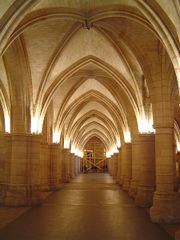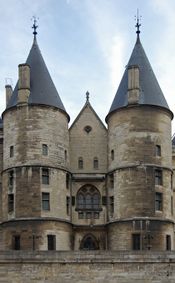Conciergerie

La Conciergerie (French pronunciation: [la kɔ̃sjɛʒəʁi]) is a former royal palace and prison in Paris, France, located on the west of the Île de la Cité, near the Cathedral of Notre-Dame. It is part of the larger complex known as the Palais de Justice, which is still used for judicial purposes. Hundreds of prisoners during the French Revolution were taken from La Conciergerie to be executed on the guillotine at a number of locations around Paris.
Contents |
The Middle Ages: Le Palais de la Cité

The Île de la Cité was occupied by the Romans during late antiquity. Later, the west part of the island was the site of a Merovingian palace; and from the 10th to the 14th centuries was the seat of the medieval Kings of France. Under Louis IX (Saint Louis) (1226–1270) and Philip IV (Philip the Fair) (1284–1314) the Merovingian palace was extended and more heavily fortified.
Louis IX added the remarkable Sainte-Chapelle and associated galleries, while Philippe IV created the towered facade on the river side and a large hall. Both are excellent examples of French religious and secular architecture of the period. The Sainte-Chapelle, built in the French royal style, was erected to house the crown of thorns brought back from the crusades, and to serve as royal chapel. The "Grande-Salle" (Great Hall) was one of the largest in Europe, and its lower story, known as "La salle des gens" survives: 64 m long, 27.5 m wide and 8.5 m high. It was used as a dining-room for the 2,000 staff who worked in the palace. It was heated with four large fireplaces and lit by many windows, now blocked up. It was also used for royal banquets and judicial proceedings. The neighboring Salle des Gardes was used as an antechamber to the Great Hall immediately above, where the king held his lit de justice (a session of parliament in the king's presence).

The early Valois kings continued to improve the palace in the 14th century, but Charles V abandoned the palace in 1358, moving across the river to the Louvre. The palace continued to serve an administrative function, and still included the chancellery and French Parliament. In 1391 the building was converted for use as a prison. Its prisoners were a mixture of common criminals and political prisoners. In common with other prisons of the time, the treatment of prisoners was very dependent on their wealth, status and connections. The very wealthy or influential usually got their own cells with a bed, desk and materials for reading and writing. Less well-off prisoners could afford to pay for simply furnished cells called pistoles, which would be equipped with a rough bed and perhaps a table. The poorest, known as the pailleux from the hay (paille) that they slept on, would be confined to dark, damp, vermin-infested cells called oubliettes (literally "forgotten places"). In keeping with the name, they were left to die in conditions that were ideal for the plague and other infectious diseaser which were rife in the insanitary conditions of the prison.
Three towers survive from the medieval Conciergerie: the Caesar Tower, named in honor of the Roman Emperors; the Silver Tower, so named for its (alleged) use as the store for the royal treasure; and the Bonbec ("good beak") Tower, which obtained its name from the torture chamber that it housed, in which victims were encouraged to "sing". The building was extended under later kings with France's first public clock being installed around 1370. The current clock dates from 1535. The concierge or keeper of the royal palace, gave the place its eventual name.
The Conciergerie and the French Revolution


The Conciergerie thus already had an unpleasant reputation before it became internationally famous as the "antechamber to the guillotine" during the Reign of Terror, the bloodiest phase of the French Revolution. It housed the Revolutionary Tribunal as well as up to 1,200 male and female prisoners at a time. The Tribunal sat in the Great Hall between 2 April 1793 and 31 May 1795 and sent nearly 2,600 prisoners to the guillotine. Its rules were simple. Only two outcomes existed — a declaration of innocence or a death sentence — and in most cases the latter was chosen. The most famous prisoners (and victims) included Queen Marie Antoinette, the poet André Chénier, Charlotte Corday, Madame Élisabeth, Madame du Barry and the Girondins, who were condemned by Georges Danton, who was in turn condemned by Robespierre, who was himself condemned and executed in a final bout of bloodletting. En route to the tumbrils, the victims walked through the Salle Saint-Louis, (Saint Louis Room), which acquired the nickname of the Salle des Perdus, the "Room of the Doomed".
After the Restoration of the Bourbons in the 19th century, the Conciergerie continued to be used as a prison for high-value prisoners — most notably the future Napoleon III. Marie Antoinette's cell was converted into a chapel dedicated to her memory. The Conciergerie and Palais de Justice underwent major rebuilding in the mid-19th century, totally altering their external appearance. While the building looks like a brooding medieval fortress, this appearance actually only dates from about 1858. A description from 1825 gives an impression of the structure before the rebuilding:
The buildings which form this prison still retain the hideous character of feudal times. The préau presents a kind of area or court, one hundred and eighty feet in length by sixty in breadth, round which is a gallery leading to the cells, and communicating by stairs to the upper storeys. It was partly constructed in the thirteenth century, and partly rebuilt in modern times, and is ten or twelve feet below the level of the adjacent streets; it serves as a promenade for the prisoners. The dungeons, which have not been used for the last thirty years, are twenty-three feet in length by eleven and a half in height.[1]
The Conciergerie was decommissioned in 1914 and was opened to the public as a national historical monument. It is today a popular tourist attraction, although only a relatively small part of the building is open to public access — much of it is still used for the Paris law courts.
References
Sources
- Lorentz, Phillipe; Dany Sandron (2006). Atlas de Paris au Moyen Âge. Paris: Parigramme. pp. 238 pp. ISBN 2840964023.
External links
- Official website
- Ministry of Culture database entry for la Conciergerie (French)
- Ministry of Culture photos
|
|||||||